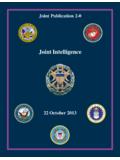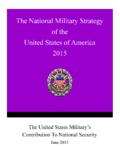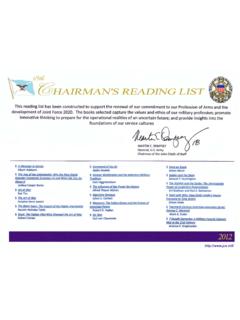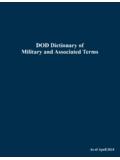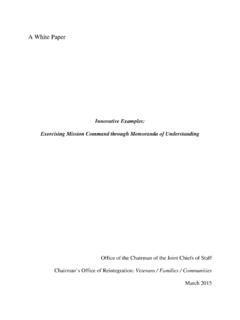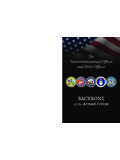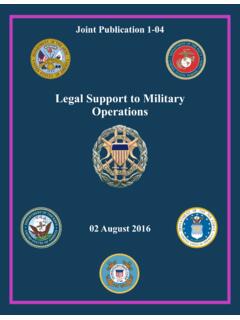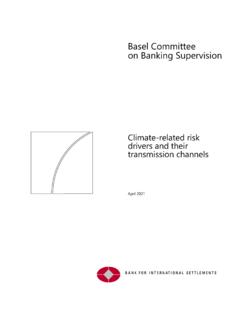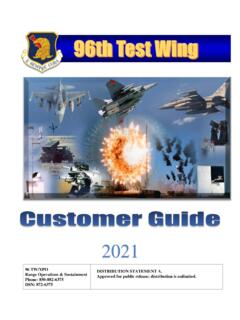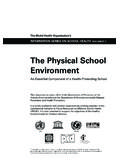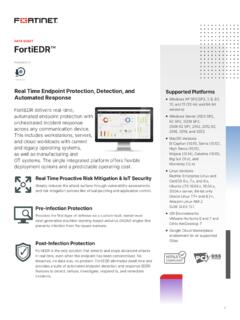Transcription of TMENT FT HISWE'LLDEFEND - Joint Chiefs of Staff
1 DEPAOTMENTFTHEARMY EUNITEDSTATSOAFAMERICRTHISWE'LLDEFENDJ oint Publication 3-13 Information Operations27 November 2012 Incorporating Change 120 November 2014i PREFACE 1. Scope This publication provides Joint doctrine for the planning, preparation, execution, and assessment of information operations across the range of military operations. 2. Purpose This publication has been prepared under the direction of the Chairman of the Joint Chiefs of Staff . It sets forth Joint doctrine to govern the activities and performance of the Armed Forces of the United States in Joint operations and provides the doctrinal basis for US military coordination with other US Government departments and agencies during operations and for US military involvement in multinational operations.
2 It provides military guidance for the exercise of authority by combatant commanders and other Joint force commanders (JFCs) and prescribes Joint doctrine for operations, education, and training. It provides military guidance for use by the Armed Forces in preparing their appropriate plans. It is not the intent of this publication to restrict the authority of the JFC from organizing the force and executing the mission in a manner the JFC deems most appropriate to ensure unity of effort in the accomplishment of the overall objective. 3. Application a. Joint doctrine established in this publication applies to the Joint Staff , commanders of combatant commands, subunified commands, Joint task forces, subordinate components of these commands, and the Services.
3 B. The guidance in this publication is authoritative; as such, this doctrine will be followed except when, in the judgment of the commander, exceptional circumstances dictate otherwise. If conflicts arise between the contents of this publication and the contents of Service publications, this publication will take precedence unless the Chairman of the Joint Chiefs of Staff , normally in coordination with the other members of the Joint Chiefs of Staff , has provided more current and specific guidance . Commanders of forces operating as part of a multinational (alliance or coalition) military command should follow multinational doctrine and procedures ratified by the United States.
4 For doctrine and procedures not ratified by the United States, commanders should evaluate and follow the multinational command s doctrine and procedures, where applicable and consistent with United States law, regulations, and doctrine. For the Chairman of the Joint Chiefs of Staff : CURTIS M. SCAPARROTTI Lieutenant General, Army Director, Joint Staff Preface ii JP 3-13 Intentionally Blank SUMMARY OF CHANGES CHANGE 1 TO Joint PUBLICATION 3-13 DATED 27 NOVEMBER 2012 Describes techniques for assessing information related capabilities (IRC) and techniques for assessing the integration of the IRCs in support of the Joint force commander s objectives.
5 Expands guidance for the 8-step assessment process. Provides additional information about private sector assessment techniques, including the theory of change. Expands discussion of sound assessment with a focused, organized approach that is being developed in conjunction with the initial operation plan. Emphasizes the need for assessments to be periodically adjusted to avoid becoming obsolete. iii Summary of Changes Intentionally Blank iv JP 3-13 TABLE OF CONTENTS PAGE EXECUTIVE SUMMARY .. ix CHAPTER I OVERVIEW Introduction .. I-1 The Information Environment .. I-1 The Information and Influence Relational Framework and the Application of Information-Related Capabilities.
6 I-3 CHAPTER II INFORMATION OPERATIONS Introduction ..II-1 Terminology ..II-1 Information Operations and the Information-Influence Relational Framework ..II-1 The Information Operations Staff and Information Operations Cell ..II-2 Relationships and Integration ..II-5 CHAPTER III AUTHORITIES, RESPONSIBILITIES, AND LEGAL CONSIDERATIONS Introduction .. III-1 Authorities .. III-1 Responsibilities .. III-1 Legal Considerations .. III-3 CHAPTER IV INTEGRATING INFORMATION-RELATED CAPABILITIES INTO THE Joint OPERATION PLANNING PROCESS Introduction .. IV-1 Information Operations Planning .. IV-1 Information Operations Phasing and Synchronization.
7 IV-11 CHAPTER V MULTINATIONAL INFORMATION OPERATIONS Introduction .. V-1 Other Nations and Information Operations .. V-2 Multinational Information Operations Considerations .. V-2 Planning, Integration, and Command and Control of Information Operations in Multinational Operations .. V-3 v Table of Contents Multinational Organization for Information Operations Planning .. V-5 Multinational Policy Coordination .. V-5 CHAPTER VI INFORMATION OPERATIONS ASSESSMENT Introduction .. VI-1 Understanding Information Operations Assessment .. VI-1 Purpose of Assessment in Information Operations .. VI-2 Impact of the Information Environment on Assessment.
8 VI-2 The Information Operations Assessment Process .. VI-3 Barriers to Information Operations Assessment .. VI-10 Organizing for Operation Assessment .. VI-10 Measures and Indicators .. VI-11 Considerations .. VI-13 Categories of Assessment .. VI-13 APPENDIX A References .. A-1 B Administrative Instructions ..B-1 GLOSSARY Part I Abbreviations and Acronyms .. GL-1 Part II Terms and Definitions .. GL-3 FIGURE I-1 The Information Environment .. I-2 I-2 Target Audiences .. I-4 I-3 Application of Means to Achieve Influence .. I-6 I-4 Application of Information-Related Capabilities to Achieve Influence.
9 I-7 I-5 Influence Leads to Achievement of an End(s) .. I-8 II-1 Notional Operation Plan Phases ..II-2 II-2 Information Operations Cell Chief Functions ..II-5 II-3 Notional Information Operations Cell ..II-6 II-4 Notional Joint Interagency Coordination Group Structure ..II-8 II-5 Notional Joint Intelligence Support Element and Joint Intelligence Operations Center ..II-11 IV-1 Information Operations Planning within the Joint Operation Planning Process .. IV-3 IV-2 Examples of Measures of Performance Feedback .. IV-8 IV-3 Possible Sources of Measures of Effectiveness Feedback .. IV-9 V-1 Information Operations in the Multinational Environment.
10 V-1 vi JP 3-13 Table of Contents V-2 Notional Multinational Information Operations Coordination Board .. V-4 VI-1 Information Operations Assessment Framework .. VI-3 vii Table of Contents Intentionally Blank viii JP 3-13 EXECUTIVE SUMMARY COMMANDER S OVERVIEW Provides an Overview of Information Operations (IO) and the Information Environment Describes IO and Its Relationships and Integration Addresses IO Authorities, Responsibilities, and Legal Considerations Explains Integrating Information-Related Capabilities into the Joint Operation Planning Process Covers Multinational Information Operations Overview The ability to share information in near real time, anonymously and/or securely, is a capability that is both an asset and a potential vulnerability to us, our allies, and our adversaries.
